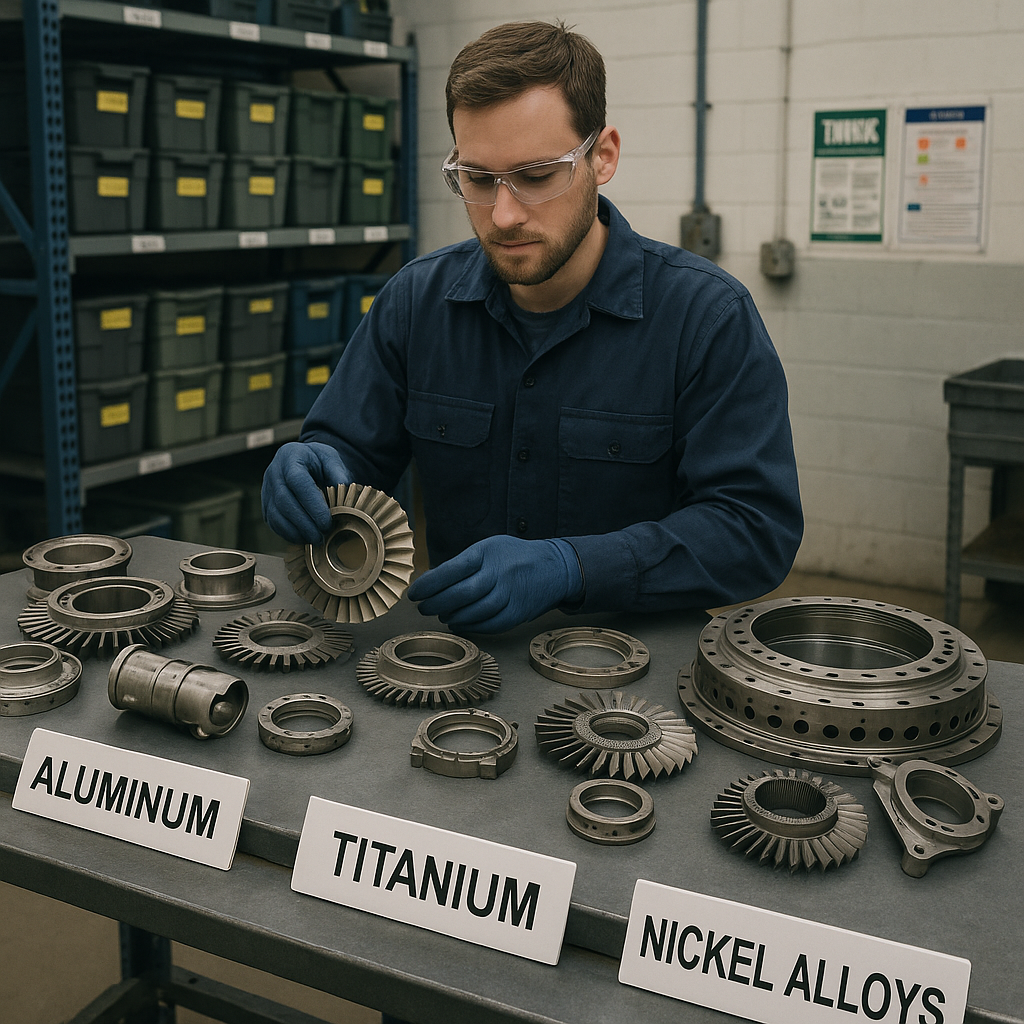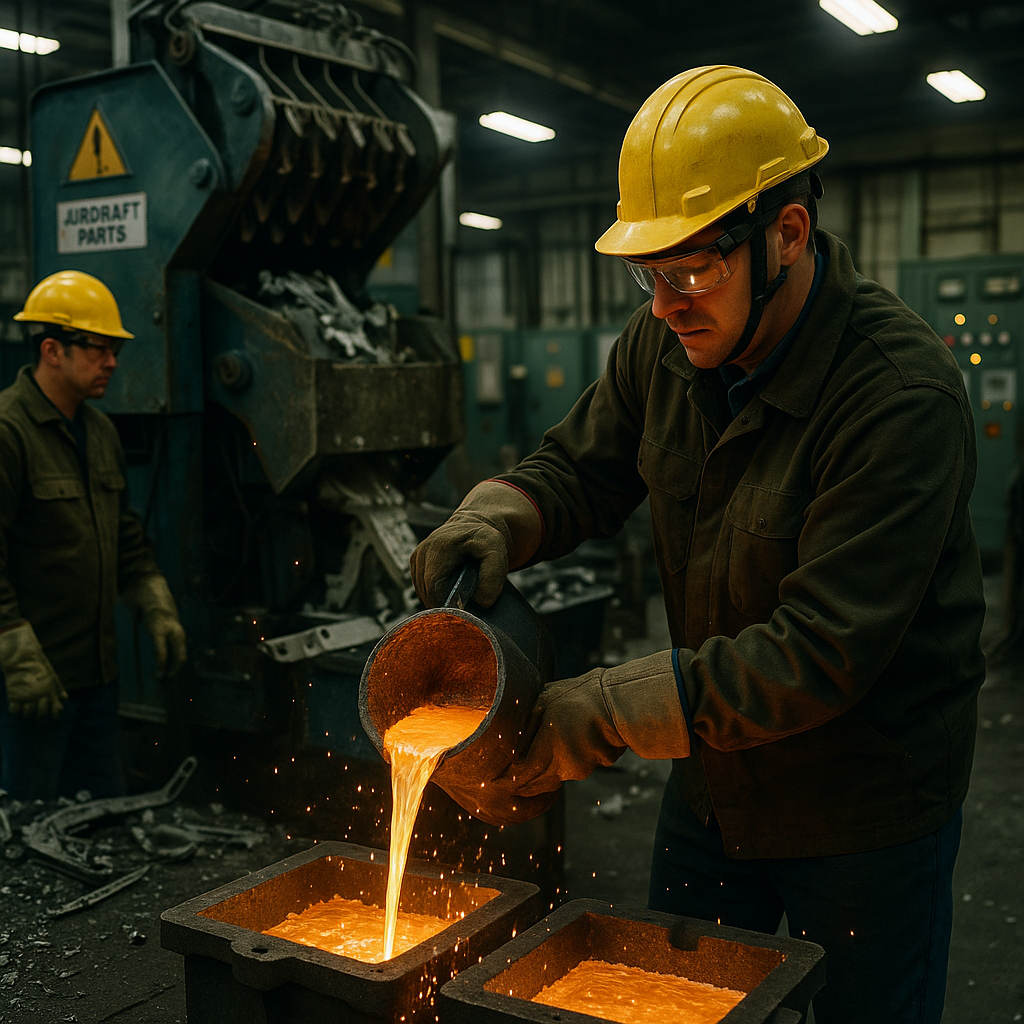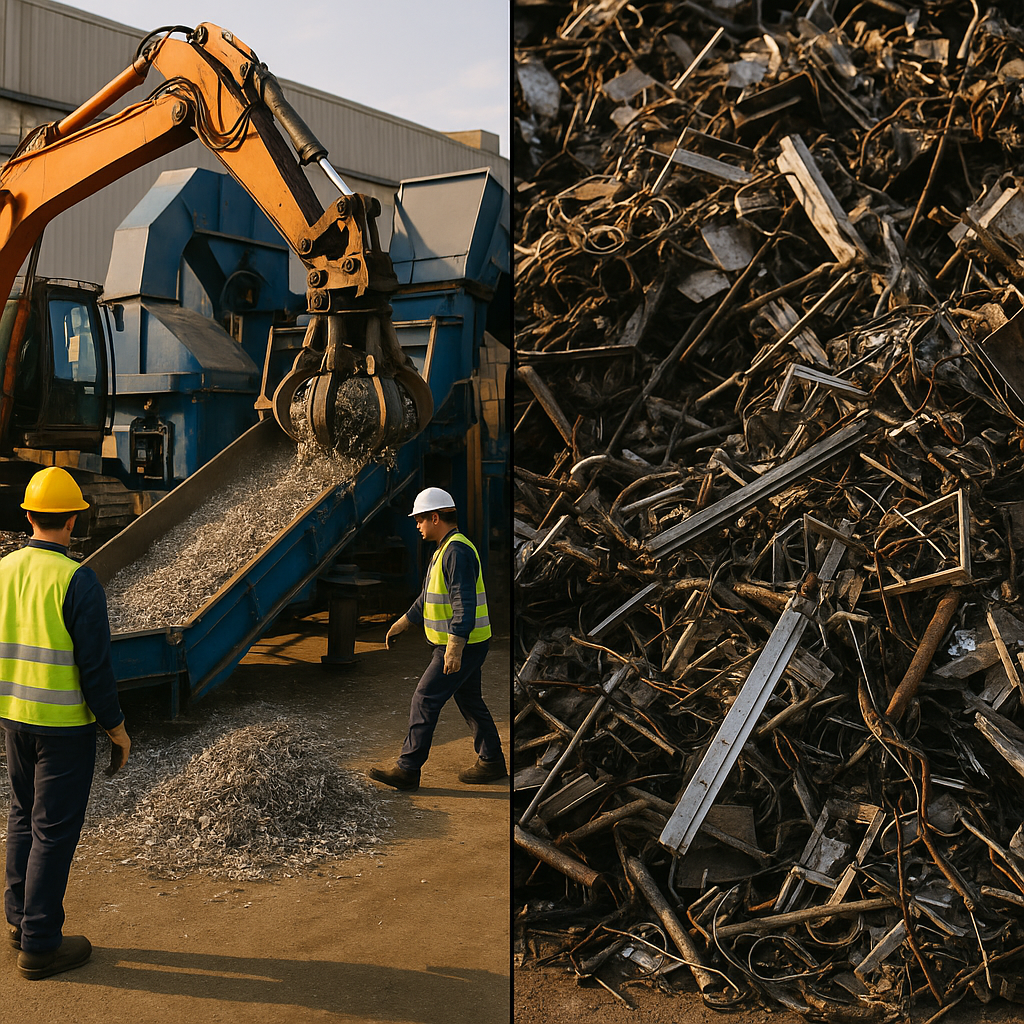5901 Botham Jean Blvd, Dallas, TX 75215
Aerospace Alloy Recycling: Processes, Benefits, and Future of Sustainable Aviation Metals
October 8, 2025Did you know that up to 80% of an aircraft’s weight consists of recyclable metals? This statistic highlights the significant potential for material recovery in the aerospace industry. Aerospace alloy recycling transforms end-of-life aircraft and manufacturing waste into valuable resources instead of landfill material.
Aerospace alloy recycling involves reclaiming and reprocessing specialized metal combinations from retired aircraft and production scrap. The process focuses primarily on high-value metals like aluminum, titanium, and nickel-based superalloys. These materials are crucial components in everything from aircraft frames to jet engine parts.
The aerospace industry faces growing pressure to adopt sustainable practices. With increasing raw material costs and environmental regulations, recycling has become a strategic priority. Aircraft manufacturers now design with recyclability in mind, recognizing that today’s planes will become tomorrow’s material feedstock for new aerospace components.
What Are the Key Aerospace Alloys Being Recycled?

The aerospace industry focuses its recycling efforts on two high-value metal categories: aluminum alloys and titanium alloys. These materials are essential for modern aircraft construction, offering outstanding performance while being recyclable, which helps preserve their valuable properties.
Aluminum Alloys: The Airframe Workhorses
Aluminum alloys are central to aerospace manufacturing, comprising around 80% of civil aircraft components by weight. Their popularity is due to their lightweight nature and structural integrity. Recycling concentrates on two vital aluminum series:
- 2XXX Series Alloys: These aluminum-copper alloys deliver excellent fatigue resistance and high strength. They are commonly used in wings, fuselage skin, and other stress-bearing parts requiring mechanical stability.
- 7XXX Series Alloys: Featuring zinc as the main alloying element, these materials provide the highest strength among aluminum alloys. They are used in high-stress areas like wing spars and pressure bulkheads.
When recycled, these aerospace-grade aluminum alloys retain their valuable mechanical properties. The remelting process requires only 5% of the energy needed to produce primary aluminum, making them economically viable for closed-loop recycling systems.
Titanium Alloys: Strength in Specialized Applications
Titanium alloys play a crucial role in modern aircraft, with their usage increasing in each new generation. While they constitute a smaller portion of total aircraft weight, their value and performance make them prime recycling candidates.
- Ti-6Al-4V: This primary titanium alloy comprises about 50% of all titanium used in aerospace. It includes 6% aluminum and 4% vanadium, offering an exceptional strength-to-weight ratio that is 40% lighter than steel with comparable strength.
- High Temperature Grades: These specialized titanium alloys are used in engine components, tolerating temperatures up to 600°C while keeping their structural integrity.
Titanium’s corrosion resistance and compatibility with carbon fiber composites make it critical in aircraft design. As Boeing and Airbus increase titanium usage in models like the 787 Dreamliner and A350, effective titanium recycling becomes increasingly important.
Why These Alloys Are Recycling Priorities
Certain factors make these aerospace alloys valuable in recycling:
- Material Cost: Producing primary aluminum and titanium is energy-intensive and costly. Titanium production demands 361 MJ of energy per kilogram, highlighting the value of recycled sources.
- Property Retention: Unlike many materials that degrade during recycling, properly processed aerospace alloys maintain most of their key mechanical properties, allowing them to re-enter high-value applications.
- Environmental Impact: Recycling aluminum cuts carbon dioxide emissions by 95% compared to primary production, with titanium’s environmental benefits being even greater.
Major aerospace manufacturers acknowledge these benefits. Boeing and Alcoa (now Howmet Aerospace) launched a closed-loop program in 2013 to recycle over 8 million pounds of high-grade aluminum scrap annually. Similar initiatives for titanium recovery are run by companies like Rolls-Royce via the Revert program, which processes and reuses more than 95% of manufacturing waste and used parts.
The main challenge in recycling these alloys is maintaining precise alloy compositions and avoiding contamination. Advanced sorting technologies and improved dismantling practices continue to enhance the quality of recovered aerospace alloys, supporting the sustainability of the aerospace manufacturing cycle.
How Does the Aerospace Alloy Recycling Process Work?

The aerospace alloy recycling process begins with the careful disassembly of retired aircraft. Unlike conventional scrap processing, this initial phase requires precision to preserve the integrity and value of high-performance alloys. Technicians meticulously separate components based on their metal composition, preventing cross-contamination that would compromise the quality of the recycled material.
Following disassembly, advanced sorting technologies ensure proper material classification. X-ray fluorescence (XRF) analyzers identify specific alloy compositions by measuring the characteristic radiation emitted when materials are excited by X-rays. This non-destructive testing method distinguishes between various aluminum and titanium alloy grades with exceptional accuracy. Similarly, Laser-Induced Breakdown Spectroscopy (LIBS) technology analyzes the atomic emission spectra produced when laser pulses interact with material surfaces, providing rapid identification of alloy types.
Sorting is critical for aerospace alloys. The industry limits impurity levels of elements like silicon and iron to a maximum of 0.40% in many applications. Without proper sorting, these strict specifications cannot be met in the recycled product.
For aluminum alloys, the next stage involves mechanical pre-treatment through shredding, crushing, or granulating. This process reduces the material’s size and increases its surface area for more efficient melting. Thermal decoating removes paints, sealants, and other contaminants from the aluminum surface. The processed scrap then undergoes melting in specialized furnaces at temperatures appropriate for the specific alloy—typically between 700-760°C for aerospace-grade aluminum.
During the melting process, fluxes are added to bind and absorb impurities, which are then removed as dross. Chlorine gas injection may be used to eliminate additional impurities through flotation. The molten material undergoes degassing to remove dissolved hydrogen, which could otherwise create porosity in the final product.
For titanium aerospace alloys, the recycling path differs slightly. After identification and sorting, the material undergoes specialized contaminant removal processes to maintain the metal’s reactivity and structural properties. EcoTitanium, a European recycling venture, has pioneered methods capable of producing up to 75% recycled titanium ingots while using only a quarter of the energy required for virgin titanium production.
The final stages for both metals involve careful remelting and alloying. Elements may be added to adjust the composition to meet aerospace specifications. For instance, in 7075 aluminum alloys used in aircraft structures, precise amounts of zinc, magnesium, and copper must be maintained. The melt is then cast into ingots, billets, or other forms ready for manufacturing processes.
Quality control testing ensures that the recycled material meets aerospace standards. This includes chemical composition analysis, mechanical property testing, and microstructure examination. The recycled alloy can re-enter the aerospace supply chain only when all specifications are met.
The aerospace alloy recycling process is a notable achievement in materials science. It transforms end-of-life components into high-performance materials while using significantly less energy than primary production—just 5% of the energy for aluminum and 25% for titanium—resulting in proportional reductions in carbon emissions.
What Are the Benefits and Challenges of Aerospace Alloy Recycling?

Aerospace alloy recycling offers significant environmental and economic advantages in a resource-constrained world. The benefits extend beyond waste reduction to significant energy savings and emissions cuts, contributing to efforts against climate change.
Recycling aluminum, the predominant metal in aircraft structures, uses only 5% of the energy required for primary production. This efficiency results in approximately a 95% reduction in greenhouse gas emissions compared to mining and processing virgin materials. For specialized aerospace components containing elements like rhenium and tantalum, the energy savings are even greater, exceeding that of aluminum recycling more than tenfold.
Key Benefits of Aerospace Alloy Recycling
Resource conservation is a primary advantage of aerospace recycling. Aircraft contain valuable metals like aluminum, titanium, nickel alloys, and specialty elements, which are scarce or prone to supply chain vulnerabilities. Recycling reduces reliance on mining operations and conserves natural resources for future generations.
The economic benefits are equally compelling. With thousands of aircraft nearing end-of-life status in the next two decades, recycling presents a significant revenue opportunity. The Aircraft Fleet Recycling Association estimates that approximately 12,000 aircraft will be decommissioned in the coming years, offering an enormous reservoir of high-value materials.
Moreover, closed-loop recycling systems create local, predictable supply chains that reduce risk from geopolitical disruptions and price volatility. This is crucial for specialized aerospace alloys containing critical elements with limited global supply.
Persistent Challenges in Aerospace Recycling
Despite these benefits, aerospace alloy recycling faces complex technical challenges. Maintaining alloy purity is one of the most significant hurdles. Aircraft alloys are highly specialized with precise compositions and extremely low tolerance for impurities. Recycling processes must preserve these exact specifications to meet stringent aerospace safety standards.
Material separation presents another major obstacle. Modern aircraft contain complex alloys designed for extreme conditions. Separating these materials requires sophisticated chemical treatments, high-temperature refining, and precision machinery, demanding substantial investment and technical expertise.
Composite materials used in newer aircraft add further recycling difficulties. These combine carbon fibers with polymer matrices that are hard to separate and process effectively. Traditional recycling methods for metals cannot handle these advanced materials.
The economic equation also presents problems. The specialized technologies needed for aerospace recycling, including laser-based sorting systems, vacuum separation, and electrolysis, are energy-intensive and costly. In some cases, sourcing virgin materials remains cheaper than recycling, slowing industry adoption.
Industry Innovations Driving Progress
The aerospace sector is actively developing solutions to these challenges. Advanced sorting technologies like Laser-Induced Breakdown Spectroscopy (LIBS) are improving alloy separation accuracy and reducing contamination risk. This technology allows recyclers to sort materials with previously unattainable precision.
Additive manufacturing presents another promising approach. Converting titanium scrap into powder for 3D printing reduces waste while enabling the creation of complex aerospace components with high precision. This process retains the value of specialty alloys instead of downgrading them.
Closed-loop recycling systems are gaining traction among manufacturers. These systems recapture metal waste during production and reintegrate it into the manufacturing process, minimizing material losses and maintaining alloy purity.
Plasma arc technology is promising for breaking down complex alloys while preserving material quality. This innovation improves the recovery of valuable elements from aerospace scrap with minimal waste generation.
Continued investment in these technologies and the development of specialized recycling infrastructure are gradually overcoming barriers to effective alloy recycling in the aerospace industry. As these innovations mature, they promise to transform end-of-life aircraft from environmental liabilities into valuable material resources.
What is the Future of Aerospace Alloy Recycling?

The future of aerospace alloy recycling focuses on technological innovation and industry collaboration. Advanced recycling technologies are evolving to efficiently handle the complex compositions of aerospace-grade alloys. These innovations enable higher recovery rates while maintaining the strict quality standards essential for aviation applications.
Closed-loop recycling systems mark a significant improvement in the aerospace industry’s sustainability approach. Companies like Airbus and Constellium have demonstrated how aircraft fuselage materials can be recycled into new high-performance alloys. This process uses only 5% of the energy required for primary production and generates 95% fewer CO₂ emissions, making a strong case for wider adoption.
Additive manufacturing with recycled metal powders is emerging as a transformative technology in aerospace alloy recycling. This approach not only reduces waste during production but also creates opportunities for using recycled materials in new components. The industry is increasingly adopting methods like directed energy deposition and powder bed fusion to fabricate parts with minimal material consumption while maintaining structural integrity.
The aerospace industry’s commitment to sustainability will continue driving recycling innovations. As manufacturers face growing pressure to reduce carbon footprints and minimize waste, aerospace alloy recycling will become integral to their environmental strategies. The circular economy model these efforts support conserves valuable resources and enhances the long-term viability of aerospace manufacturing.
For organizations looking to implement effective metal recycling programs or improve their existing sustainability practices, contact Okon Recycling at 214-717-4083.
